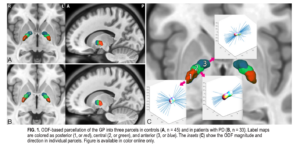
The intricate anatomy of the human brain has captivated generations. Magnetic resonance imaging can now detect this intricate anatomy in extraordinary radiological detail.
Interestingly, this intricate anatomy changes remarkably every few millimeters in a brain region called the globus pallidus or GPi. Neurosurgeons frequently interrogate GPi during surgery for Parkinson’s disease. So, we wondered whether these divisions of distinct anatomy in the GPi have unique functions.
We discovered unique radiological signatures of the GPi divisions that serve motor and nonmotor functions. Furthermore, in patients undergoing focused ultrasound ablation, we identified two hotspots in the motor division that correlated with specific patient symptoms (UPDRS improvement and dyskinesia reduction).
Will these findings lead to a personalized surgical approach to treating Parkinson’s disease and other movement disorders?